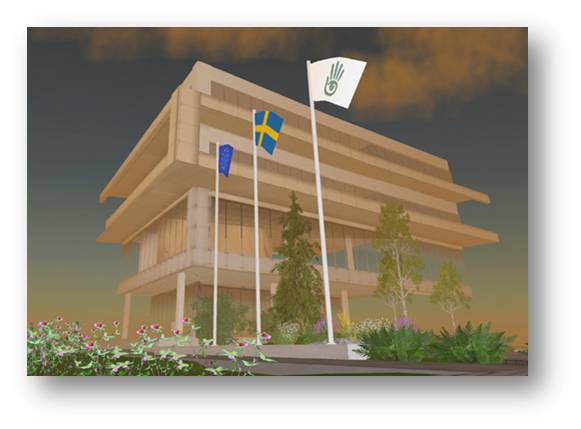The Metaverse
Creating New Realities
Recently, Facebook, or as it is now called, Meta, announced that it would be moving into developing technology within the sphere of the “Metaverse.” What this actually means remains to be seen, as all that they claimed was that they would be shifting their focus from existing social media platforms and tech into the meta space. They claim to be releasing their own headset and that “users will be able to add virtual objects to the real world. They could hang out with friends as well as appear in real meetings as holograms” (Griffin)
 |
|---|
| The new Meta logo |
The concept of the metaverse is not new, nor is the name. The term “Metaverse,” in a similar fashion to “Virtual Reality” was coined in s science fiction book. Snow Crash, written by Neil Stephenson and published in 1992, showed a dystopian future anarchy-capitalist America, one where the mainly impoverished citizens, crushed by the controlling fist of large corporations, find an escape via the Metaverse, an MMO (massively multiplayer online game) where they can be free to live actual lives. Since then, this concept has popped up several times, both in fiction and in reality. The concept is extremely similar to that shown in the novel and film Ready Player One, and we have seen an attempted actualization of a metaverse in the MMO Second Life, which launched in 2003. There is as of yet no official definition for the term, but in general it refers to any sort of version of the internet that allows for relative freedom within virtual environments.
 |
|---|
| Neil Stephenson's Snow Crash |
Second Life has been by far the most successful attempt to form a fully-functioning metaverse. It currently has a dedicated user base of about 900,000, and at its peak in the late 2000s, this number was supposedly in the millions. Users have formed long lasting friendships, with even some marriages coming out of relationships made on the platform. Some people make their living in Second Life, doing in-game business and then trading the virtual currency, Linden dollars, for real-world currency. Between 2007 and 2008, real-life countries opened virtual embassies; The Maldives, Sweden, Colombia, Serbia, Estonia, North Macedonia, the Philippines, Albania, and Malta. There is minimal information available, but due to the decline in users, its assumed these are no longer in operation. Also during its peak in the late 2000s, there were a number of small, real-world companies that attempted to operate and meet within the metaverse. These were mainly tech-focused companies, and while it did technically work, it was not a particularly long-lasting phenomenon.(Diplomacy) Very few of the attempts to fully integrate real-world institutions into Second Life lasted into the 2010s.
 |
|---|
| The Swedish Embassy in Second Life |
It may sound like Second Life is extremely similar to Meta’s plan for the metaverse, and that is because it is. The only concrete difference seems to be the Meta’s version will seemingly solely exist, or at least be extremely focused on an immersive VR experience. Second Life does support the use of VR headsets, but as its heyday was in the 2000s when VR was far less popular, it is not an integral part of the platform.
 |
|---|
| The Second Life Logo |
It is certainly possible that due to their numerous similarities, Meta’s metaverse will follow a similar trajectory to Second Life, meaning that it will have a boom in popularity out of novelty, and then eventually fizzle out for the general public, while maybe still retaining a cult of dedicated users. However, this theory ignores some important factors. Primarily, that we are living in a very different world from that of the mid 2000s. Technology is much more integrated into our everyday lives. In 2005, the average person was not spending hours upon hours on the internet everyday, while this is commonplace for people in 2021. An entire generation has been raised online, and would be much more receptive to something like this than their parents would have been. As well, Meta is already one of the most powerful companies in the world. Millions of people use facebook everyday, making the possibility of transitioning from interacting with people via text boxes on a screen, to actually talking in a virtual space a more plausible one. Not to mention the normalization of social media and interacting with strangers over the internet over the past two decades. From a social point of view, this metaverse has a much greater chance of succeeding than Second Life ever did.
